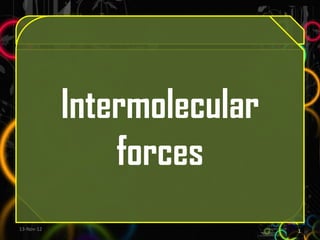Intermolecular Forces (Gaya Antarmolekul)
- 1. Intermolecular forces 13-Nov-12 1
- 2. Overview intramolecular bonds attraction in molecules intermolecular forces 13-Nov-12 2
- 3. Intermolecular forces is much weaker than intramolecular forces 13-Nov-12 KARBOHIDRAT 3
- 4. INTERMOLECULAR FORCES ---- attraction that exist between molecule 1. GAYA VAN DER WAALS ŌĆó GAYA DIPOLE-DIPOLE ŌĆó GAYA LONDON (DISPERSI) 2. IKATAN HIDROGEN 13-Nov-12 4
- 5. 1. Gaya dipole-dipole....dipole-dipole force 2. Gaya london (dispersi)....dispersion force 4. Ikatan hidrogen......hydrogen bonding 5. Ikatan ionik....ionic bonding 6. Jaringan ikatan kovalen.....covalent network 13-Nov-12 5
- 6. What should be discussed : 1. What ? 2. When? 3. Example? 4. Power? 13-Nov-12 6
- 7. London dispersion force ŌĆóThe attraction between atoms and molecules caused by the formation of instantaneous atoms in the atoms and molecules ŌĆóTwo non polar molecule ŌĆóCaused by momentary dipole 13-Nov-12 7
- 8. 13-Nov-12 KARBOHIDRAT 8
- 9. 13-Nov-12 KARBOHIDRAT 9
- 10. polarizability ŌĆó the ease with which an atom or molecule can be distorted to have an instantaneous dipole. 13-Nov-12 KARBOHIDRAT 10
- 11. Polarizability increases with: greater number of electrons Dispersion forces usually increase with molar mass. 13-Nov-12 KARBOHIDRAT 11
- 12. Effects on boiling points 13-Nov-12 12
- 13. Dipole-dipole force ŌĆó The force that exist between negative and positive ends of a polar molecule. ŌĆó Between two polar molecule + - + - Opposite attraction 13-Nov-12 13
- 14. 13-Nov-12 KARBOHIDRAT 14
- 15. Hydrogen bonding ŌĆó A form of dipole attraction in which hydrogen atom bonded to a strongly electronegative atom ŌĆó H + F, O, N .... HF, NH3, H2O ŌĆó Works like dipole-dipole but 5 times stronger 13-Nov-12 KARBOHIDRAT 15
- 16. Ionic bonding ŌĆó The forces holding ions together in ionic solids are electrostatic forces 13-Nov-12 KARBOHIDRAT 16
- 17. ŌĆó100 % covalent bond ŌĆóThere are no intermolecular force ŌĆóOnly compounds of C only (diamond, graphite) and Si (usually with Oxygen) ŌĆó very strong attraction 13-Nov-12 KARBOHIDRAT 17
- 18. 13-Nov-12 KARBOHIDRAT 18
- 19. 13-Nov-12 KARBOHIDRAT 19
- 20. power Jaringan ikatan kovalen > Ikatan ionik > Ikatan hidrogen > dipol-dipol > gaya london 13-Nov-12 20




















